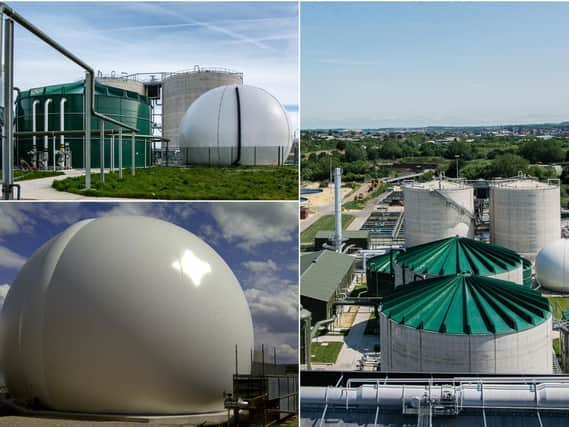This is how the Brighouse 'poo factory' will make electricity from human waste


Plans revealed for new £40m state-of-the-art 'poo factory' in BrighouseThe new ‘poo-power’ technology is official known officially as anaerobic digestion.
Ben Roche, Head of Energy and Recycling Operations at Yorkshire Water, explained how you convert human waste into electricity.
Advertisement
Hide AdAdvertisement
Hide Ad“The best way to think about the facility is it is like a human stomach. Food, i.e. sludge and waste water, comes into the facility and it is digested over a 15 day process.
“The biogas that is produced is then stored into huge gas like balloon containers which can be sent onto companies to be burnt and create electricity.
“The gas is also used back into the facility to heat up the human waste for the process.”
‘Poo power’ uses a bio-gas rich in methane which is extracted from the treatment of waste water and sewage to drive turbines.
Advertisement
Hide AdAdvertisement
Hide AdThe bio-gas, predominantly comprising of methane, is produced when bacteria feed on human and animal waste.
This process is known as anaerobic digestion and it is a way to produce green energy, as well as getting rid of waste and the microorganisms that lurk in it.
One of the simplest ways of describing anaerobic digestion to young people is the ‘farting’ of millions of tiny bugs within the waste, which produces the biogas.
Mr Roche explained that, positively, when the biogas is burnt for generating electricity, far less carbon dioxide is released than when fossil fuels are burnt.
Advertisement
Hide AdAdvertisement
Hide AdHowever, it is useful to note that using bio-gas in this way does have its limitations in that it takes the poo of 100,000 people to generate 51kW of electricity; enough for 500 light bulbs.
“We have these plants and processes already up and running in Leeds and Huddersfield.
“What we have done in the last five years is moved away from using incinerators.
“One of the reasons why we have done this is because it is a lot more environmentally friendly. The process is more cost efficient process and that is better in terms for our customers.”
Advertisement
Hide AdAdvertisement
Hide AdYorkshire Water is embracing sector in bid to drive efficiency
Yorkshire Water is embracing the sludge treatment market as part of an industry-wide effort to drive efficiency, boost resilience and deliver further innovation within the water sector.
The sludge treatment, or bioresources market as it is also known, is estimated to be worth up to £1.6bn in the UK.
Around 150,000 tonnes of sewage sludge are treated each year by Yorkshire Water, with 69 per cent converted into renewable energy through a process known as anaerobic digestion (this will be 100 per cent in 2020).
Advertisement
Hide AdAdvertisement
Hide AdThe renewable energy benefits of sludge treatment are helping Yorkshire Water keep costs down for customers. The company is investing in anaerobic digestion in a move which will deliver significantly lower operating costs by 2020.
Yorkshire Water has 11 key anaerobic digester plants across the region treating sludge, converting it into a fertiliser, and creating a biogas that is turned into green electricity.
This electricity is used to provide the power to operate its sewage treatment works.
The poo of 100,000 people can generate 51kw of electricity, enough for 500 light bulbs.
Advertisement
Hide AdAdvertisement
Hide AdIn 2014 Yorkshire Water generated 7.4 per cent of our own renewable electricity. By April 2015 the company is on track to generate 12 per cent- this is a year ahead of schedule.
Yorkshire Water’s first entirely poo powered sewage works in Bradford creates enough renewable energy to power the the large site, reducing the company’s carbon footprint by 9,000 tonnes and saving £1.3 million a year in energy costs – helping keep customer’s bills down.
Animal and human waste: Poo power from around the world
Poo Power is not a new thing. Animal and human waste has been used as a source of energy for many years in countries around the world where electricity and gas are scarce.
Small biogas plants are common in South East Asia and Africa, where animal dung is used as the fuel.
Advertisement
Hide AdAdvertisement
Hide AdIn Australia, pig excrements are used to power farms and chicken poo has been used for generating electricity in the UK.
The use of human waste to generate electricity in more developed countries is relatively new.
The London Science Museum is planning to turn the waste it gets from its three million visitors a year into electricity. The processed waste could produce as much as 1,530 kilowatt hours of electricity a year.
Poo can also be used to heat homes.
In Norway, householders are now heating their homes and offices by flushing the toilet. The sewage heat pump plant uses fridge technology to tap heat from raw sewage.
Advertisement
Hide AdAdvertisement
Hide AdMachines at the end of a 300-metre-long tunnel in a hillside in central Oslo suck heat from the sewer and transfer it to a network of hot water pipes, feeding thousands of radiators and hot water pipes in the city.
It is believed to be the biggest heating system in the world using raw sewage.